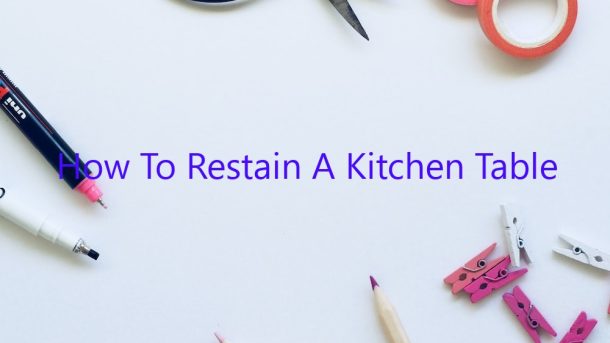Do you have a kitchen table that you’re not in love with anymore? Don’t worry, you can easily fix that by restaining it! Here’s how:
1. Start by removing all of the hardware from the table, such as the screws or bolts.
2. Next, sand the entire surface of the table. This will help the new stain to adhere better.
3. Once the table is sanded, wipe it down with a damp cloth to remove any debris.
4. Now, it’s time to choose your stain. Be sure to pick a color that will complement the rest of your kitchen.
5. Apply the stain to the table using a brush or a rag. Be sure to apply it in even strokes.
6. Let the table dry for several hours.
7. Once the table is dry, reattach the hardware and you’re done!
Contents
How do you Restain a stained kitchen table?
If your kitchen table has seen better days, don’t despair. You can give it a new lease on life by restaining it. This is a process that can completely change the look of your table, so it’s important to choose the right color. Here’s how to do it:
1. Remove any old finish from the table. You can do this by sanding it down or using a chemical stripper.
2. Choose a color that will complement the rest of your kitchen.
3. Apply the stain using a brush or a rag.
4. Let the table dry for several hours.
5. Seal the table with a coat of polyurethane.
Your table will now be good as new!
Can you Restain a table without sanding?
Table refinishing is a popular way to update the look of an old table or furniture piece. However, if you’re looking to refinish a table without sanding, is it possible?
The answer is yes – you can restain a table without sanding. However, the results may not be as smooth or as even as if you had sanded the table first. In addition, if the table has any existing paint or sealant on it, this will need to be removed before you can restain the table.
The best way to remove paint or sealant from a table is to use a chemical stripper. This will dissolve the paint or sealant and allow you to wipe it away. Be sure to read the instructions on the chemical stripper carefully, and always wear protective gloves and goggles when using it.
Once the paint or sealant is removed, you can begin to restain the table. There are many different types of stain available, so be sure to choose one that will match the look you want.
Apply the stain with a brush, making sure to get it into all the nooks and crannies of the table. Allow the stain to dry completely, then apply a sealant to protect the finish.
If you don’t want to use a chemical stripper, you can try using a heat gun to remove the paint or sealant. However, this can be more difficult and may take longer.
So, can you restain a table without sanding? The answer is yes, but the results may not be as good. If you’re willing to put in a bit of extra work, you can remove the paint or sealant with a chemical stripper, then restain the table with a brush. Be sure to apply a sealant to protect the finish.
How do you prep a table for Restaining?
Table refinishing is a great way to update the look of an old table or to restore a table that has seen better days. In order to refinish a table, you will need to prepare the surface for staining. This involves cleaning the table and removing any old finish or sealant. In this article, we will show you how to prep a table for refinishing.
First, you will need to clean the table. Use a degreaser to remove any grease or dirt from the surface. Next, use a stripper to remove the old finish or sealant. Apply the stripper to the surface and allow it to soak in for a few minutes. Then, use a scraper to remove the stripper and the old finish or sealant.
Once the surface is clean and free of old finish or sealant, you will need to sand it. Use a sanding block to sand the surface evenly. Be sure to sand in the direction of the wood grain.
Finally, you will need to apply a sealant. Use a brush to apply a thin coat of sealant to the surface. Allow the sealant to dry completely before staining the table.
Can you Restain wood table?
When it comes to furniture, there are a few different ways to keep it looking new. You can paint it, you can reupholster it, or you can restain it. If you have a wood table that you would like to keep looking new, you may be wondering if you can restain it. The answer is yes, you can restain wood table, but there are a few things you need to know before you start.
The first thing you need to know is what type of wood your table is made of. Not all types of wood are the same, and they will not all react the same way when you try to restain them. The second thing you need to know is what type of stain you want to use. There are a variety of different stains available, and each one will give your table a different look.
Once you have chosen the type of wood and the type of stain you want to use, you will need to prepare your table. This means sanding it down and removing any previous coatings or sealants. Once it is sanded down, you will need to apply the stain. Be sure to follow the instructions on the bottle, and let the stain dry completely before you use your table.
Restaining a wood table is a great way to give it a new look, but it is important to note that not all tables will react the same way. Make sure you test the stain on a small area of the table before you apply it to the entire surface. Also, be sure to allow enough time for the stain to dry completely before you use the table.
Can you stain over already stained wood?
Can you stain over already stained wood? In most cases, you can. However, the type of wood and the color of the stain you use may affect the final outcome.
The main thing to consider when staining over stained wood is the color of the new stain. If the new stain is lighter than the old one, the old stain will show through. If the new stain is darker, the old stain will be covered up.
The type of wood you’re staining is also important. Some woods, such as pine, are more porous than others and will soak up more stain. This can cause the new stain to be darker than you intended.
In general, it is usually possible to stain over already stained wood. However, it’s best to test a small area first to make sure the results are what you want.
Do you have to remove old stain before restaining?
When it comes to staining wood, there are a few things you need to know in order to get the best results. One of those things is whether or not you need to remove the old stain before you apply the new stain.
The answer to this question depends on the type of stain you are using. If you are using a water-based stain, then you do not need to remove the old stain. However, if you are using an oil-based stain, then you will need to remove the old stain before applying the new one.
There are a few reasons for this. First of all, water-based stains are not as opaque as oil-based stains. This means that they will not completely cover the old stain. Secondly, water-based stains are not as durable as oil-based stains. This means that they will not last as long as oil-based stains.
If you are using a water-based stain, then you can simply apply the new stain over the old stain. However, if you are using an oil-based stain, then you will need to remove the old stain using a stripper.
There are a few things to keep in mind when removing the old stain. First of all, you will need to use a stripper that is specifically designed for removing oil-based stains. Secondly, you will need to make sure that you read the manufacturer’s instructions carefully.
Thirdly, you will need to wear the appropriate safety gear, such as gloves and a mask. Finally, you will need to clean up any spills or messes immediately. Failure to do so could result in damage to your floors or furniture.
Do you have to remove old stain before restaining table?
There is no one definitive answer to this question. In general, it is a good idea to remove as much of the old stain as possible before restaining the table. However, if the old stain is particularly difficult to remove, you may be able to skip this step and still get good results.
The best way to remove an old stain from a table is to use a chemical stripper. If you are not comfortable using a chemical stripper, you can try using a solvent such as lacquer thinner or mineral spirits. Be sure to follow the manufacturer’s instructions carefully when using a solvent.
If you are going to be using a new stain, it is important to test it on a small area of the table first to make sure that it will achieve the desired results. Once you have tested the stain, you can begin applying it to the entire table. Be sure to work in a well-ventilated area and wear protective clothing and eyewear when staining the table.




